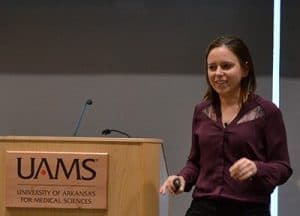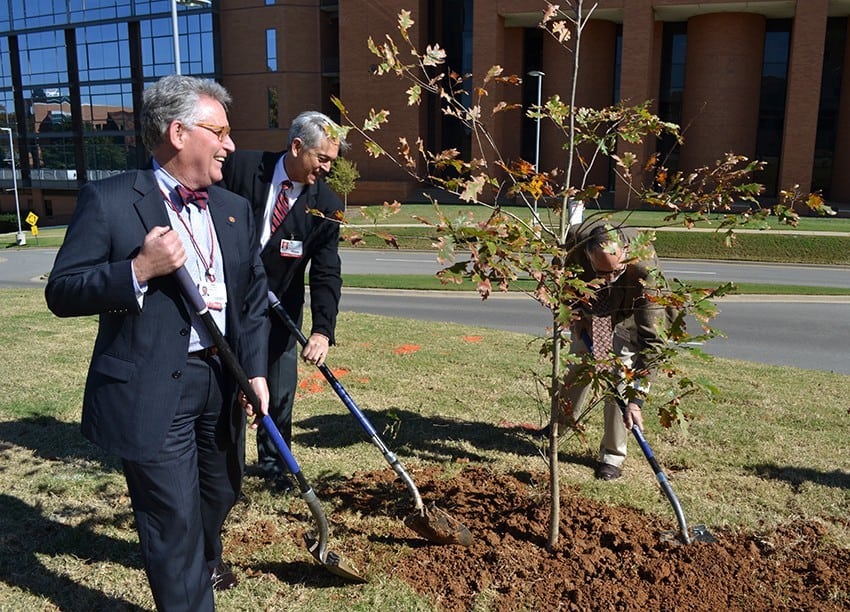UAMS’ Tree Campus USA Plants Trees
| Nov. 30, 2015 | Students, faculty and staff picked up shovels Nov. 12 to plant eight trees on campus.

UAMS grounds manager Penny Talbert (center) gets help planting a tree from pharmacy student Erin Puryear and UAMS landscape technician Kenneth Bailey.
The plantings were a service learning project of Tree Campus USA, a program that recognizes and encourages best practices in campus community forestry.
Planted along Hooper Drive on the hill in front of the Admin West building were three pecan trees, three white oaks and a Chinese pistachio. An elm tree that had been moved because of construction was replanted on the library lawn.
Grounds manager Penny Talbert said these types of trees were chosen because of their suitability for the UAMS campus. The location was ideal because of its proximity to campus irrigation systems and because the hill is an unlikely place for future building projects that could force the trees to be moved.
There are more than 800 trees from 32 tree species on the UAMS campus, Talbert said.

Calvin Helmes, a UAMS landscape technician, checks to see that a Chinese pistachio is ready to plant during a Tree Campus USA service project.
Besides the aesthetic and environmental benefits, trees provide a healing aspect for patients, which is especially important at UAMS, said Robert Airo, business manager of the Engineering and Operations Department.
Attending the service project were Erin Puryear and Madalyn Van Valkenburg, second-year pharmacy students and the founders of the Interprofessional Fresh Food Coalition that grows fresh produce for the patients at the UAMS 12th Street Health and Wellness Center.
Puryear said she wanted to support the great work that Talbert is doing with the UAMS grounds, adding that Talbert was instrumental in allowing the two students to start a vegetable garden near the dorms.
The service learning project took place two days after a workshop, “Tree Campus USA: Healthy Trees, Buildings and People,” was held in the Hospital Gallery. The workshop was sponsored by UAMS, Tree Campus USA, University of Arkansas Division of Agriculture, U.S. Forest Service, Arkansas Forestry Commission and the Arkansas Urban Forestry Council.
Alison Litchy of the Arkansas Forestry Commission said many times people think of a forest as miles of woodlands out in the country. That perception ignores the urban forest, which is “so important to our daily lives.”
Tree Campus USA, which is modeled after Tree City USA, encourages best tree-management practices for the urban forest, she said.

Alison Litchy of the Arkansas Forestry Commission discusses the importance of the urban forest during the “Tree Campus USA: Healthy Trees, Buildings and People” workshop.
The program started in 2008 with 29 campuses. As of 2014, there are 252 schools in the program, including UAMS and the University of Arkansas at Monticello.
Two other Arkansas schools, Ouachita Baptist and the University of Arkansas at Fort Smith, are ready for recertification, and three others – John Brown University, Arkansas Tech and Central Baptist College – are working on certification, to be concluded by the end of the year, Litchy said.
UAMS started working toward certification in 2011, and it became official in 2013, said Airo.
“Our goal was to improve our procedures regarding trees,” he said. “With a Tree Care Plan in place, it provides the guidelines for care of the trees and guidance on trees that we do not need on the UAMS Campus. It also has helped with placing the right tree in the right location.”
Involvement with Tree Campus USA also sends a valuable message to the community that UAMS cares about trees and the environment, he said.
Other workshop sessions were:
- Trees: Physical and Social Benefits, by Lynn Warren of Arkansas State Parks.
- Green Plants for Green Buildings, by Robin W. Connell of PLANTation Services.
- Native Tree Species, by Chris Stuhlinger of the University of Arkansas.
Jessie Casella, a UAMS research and clinical search services librarian and assistant professor who attended the workshop, said she has been a member of the UAMS Tree Campus committee since January 2013.
“All four presenters at the workshop shared practical and interesting information,” she said, adding that since she works indoors she was particularly interested in Connell’s session.
“I learned that plants can remove volatile organic compounds (VOCs) within 4-5 days of being brought into an office, reduce carbon monoxide levels by 90 percent and reduce carbon dioxide levels by at least 10 percent.”
